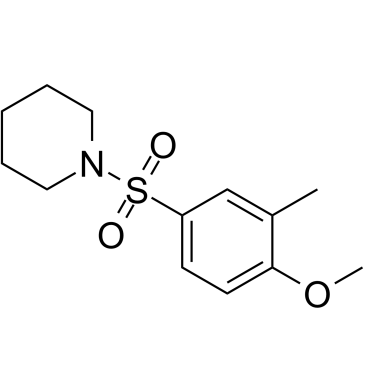AA92593 |
| Catalog No.GC61951 |
AA92593 es un antagonista selectivo y competitivo de OPN4 (melanopsina).
Products are for research use only. Not for human use. We do not sell to patients.

Cas No.: 457961-34-1
Sample solution is provided at 25 µL, 10mM.
AA92593 is a selective and competitive OPN4 (melanopsin) antagonist[1][2].
AA92593 is a competitive melanopsin antagonist, its presence in the retinal-binding pocket of melanopsin leads to the displacement of retinal, which could trigger a downstream signaling that would ultimately result in Per1 increased expression[1].AA92593 is shown to be specific because it competes with retinaldehyde for the melanopsin retinal binding site which is very distinct from other opsins[1].Inhibition of melanopsin activity with AA92593 increases a-MSH expression and induces melanin dispersion in the melanophores, which darkens the embryo[3].AA92593 exhibits an IC50 of 665 nM in CHOOpn4 cells[4].
AA92593 is able to decrease IOP in rabbits living under normal light condition[2].AA92593 produces an increment in melatonin levels resulting in a drop of IOP[2].
References:
[1]. Maria NathÁlia Moraes, et al. Melanopsin, a Canonical Light Receptor, Mediates Thermal Activation of Clock Genes. Sci Rep. 2017 Oct 25;7(1):13977.
[2]. Victoria Eugenia LledÓ, et al. Yellow Filter Effect on Melatonin Secretion in the Eye: Role in IOP Regulation. Curr Eye Res. 2019 Jun;44(6):614-618.
[3]. Gabriel E Bertolesi, et al. Melanopsin photoreception in the eye regulates light-induced skin colour changes through the production of α-MSH in the pituitary gland. Pigment Cell Melanoma Res. 2015 Sep;28(5):559-71.
[4]. Kenneth A Jones, et al. Small-molecule antagonists of melanopsin-mediated phototransduction. Nat Chem Biol. 2013 Oct;9(10):630-5.
Average Rating: 5 (Based on Reviews and 30 reference(s) in Google Scholar.)
GLPBIO products are for RESEARCH USE ONLY. Please make sure your review or question is research based.
Required fields are marked with *




















